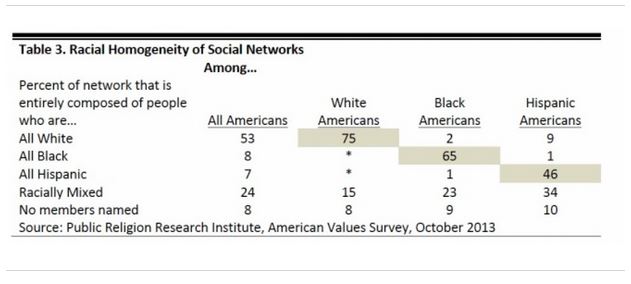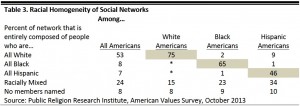As a nation, and as a church, are we serious about improving racial relationships? In our social networks there are few persons of others races. That’s where we’ve been throughout our history, and where we are now. We believe race relations are worsening even as a greater percentage of Americans acknowledge more needs to be done to achieve racial equality. Our neighborhoods (and schools) are becoming more segregated, not less. Can we be serious about improving race relations and achieving racial equality and yet not have friendships with those of other races?
Several items on the topic have recently appeared. Links and snippets are provided below.
Are race relations really worse under President Obama? Washington Post Aug 5
In the months after Barack Obama was sworn in as the 44th president of the United States, 66 percent of Americans told the researchers behind the New York Times /CBS News poll that race relations in the United States were generally good. Perhaps most notably, the long-standing gap between the share of white Americans and black Americans who felt this way narrowed in a way it hadn’t since 1990. Race relations in America were good, and on this black-and-white America generally and pretty overwhelmingly agreed.
Whatever the heady admixture of ideas and emotions that produced that data, that picture of America in 2009 is now orphaned. The latest New York Times/CBS News poll shows just 37 percent of all Americans describe race relations as generally good. (Accordingly, other polling in recent months has shown a majority of Americans believe race relations have gotten worse under the nation’s first black president.)
Making Friends in New Places New York Times Aug 5
Humans are hard-wired for friendship in one final way: We like the company of people we resemble, a property known as homophily. We evolved as a species by preferring those with shared objectives — all the better to coordinate a hunt for a mammoth. But natural selection has equipped us with a taste for similarity at a cost: the loss of new insights and information that lead to innovation.
One of the most dispiriting things I have observed as a faculty member is that, despite herculean efforts to curate diversity in the student body through the admissions process, students often restrict themselves to social groups defined by narrow traits. In dining halls, swimmers sit with swimmers, computer scientists with computer scientists, conservatives with conservatives, Latinos with Latinos.
Race and Americans’ Social Networks PRRI Aug 28, 2014
There is little variation among white American subgroups in terms of the racial homogeneity of their social networks. White Republicans (81 percent) are no different from white Democrats (78 percent) in that they both have social networks that are entirely composed of whites. Among white independents, 73 percent say their social networks are comprised entirely of people who are white.
The most and least racially diverse U.S. religious groups Pew Research July 27
Demographics of the House of Deputies 78th General Convention HOD website Aug
More than three-quarters of the House of Deputies is white, while 9% is black, African American, or Afro Caribbean and 7% is Latino. Indigenous and Native American deputies make up 3% of the House, and Asian deputies account for 2%. According to the Pew Research Center’s most recent Religious Landscape Survey, the Episcopal Church’s members in 2014 were 90% white, 4% black, 2% Latino, and 1% Asian.
Of course most black Episcopalians are members of traditionally black congregations. Someone said that the black church is the last black institution not taken over by whites, and that seems to be true within our denomination.
This American Life explains why school segregation still exists — and is so hard to change Vox Aug 2
The most powerful section in Hannah-Jones’s report is from a meeting in Francis Howell, where parents vehemently objected to accepting poorer, black students from a failing district, even though they were required to by law. (It starts at the 24-minute mark in the audio above.)
- “I want to know where the metal detectors are going to be, and I want to know where your drug-sniffing dogs are going to be,” one mother said, to rapturous applause.
- “I shopped for a school district,” another said. “I deserve to not have to worry about my children getting stabbed or taking a drug or getting robbed.”
- “We don’t have to like it, and we don’t have to make it easy,” another man suggested, saying the school district should start 20 minutes or 40 minutes earlier, “making it a little less appealing” for the Normandy students to attend.
What’s your reaction? Given where it is today in terms of its own diversity and integration, and that of its members, what should The Episcopal Church’s next steps be in order to be effective in the struggle for racial equality?




